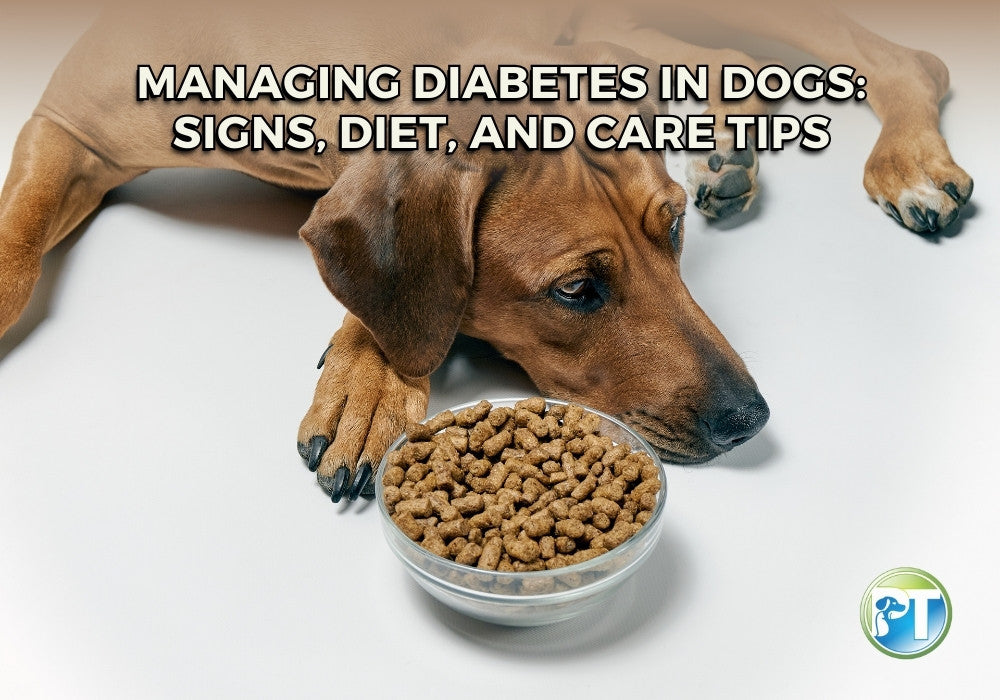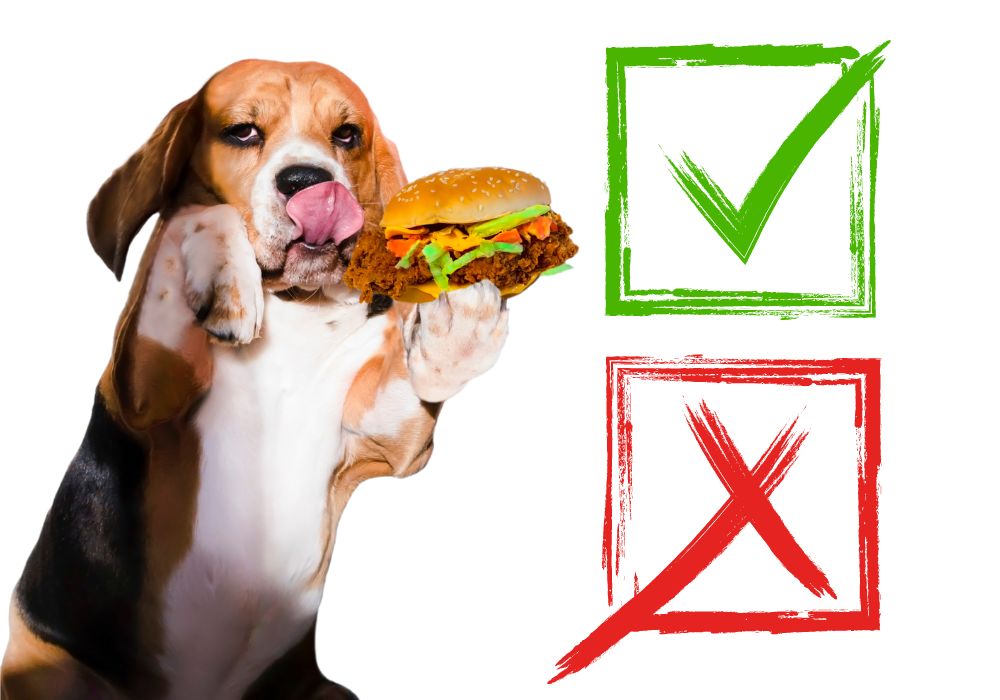Managing Diabetes in Dogs – Signs, Diet, and Care Tips

Did you know dogs can get diabetes too? Just like us, our furry companions can develop this condition, disrupting their body's ability to regulate blood sugar levels. This can lead to a cascade of health problems if left unchecked.
Thankfully, there are ways to manage it, and one of the most important is through diet.
In this article, we'll break down the key things you need to know about feeding your diabetic dog. We'll explore what foods are off-limits and what their ideal diet should look like.
But First, What Are the Signs of Diabetes in Dogs?
Recognizing the early signs of diabetes is crucial for your pup’s health. Here are some key indicators that your pet might be diabetic:
- Increased thirst
- Frequent urination
- Weight loss despite an increased appetite
- Lethargy
- Cloudy eyes
- Recurring infections
If you observe any of these symptoms, consult your veterinarian promptly. Early diagnosis and management can make a significant difference in your pet’s quality of life.
Key Dietary Considerations for Diabetic Dogs
When managing your diabetic dog's diet, there are several key factors to consider:
1. Consistent Feeding Schedule
Maintain a consistent feeding schedule to help regulate your dog's blood sugar levels. Feed your dog at the same times each day and coordinate mealtimes with insulin injections if applicable.

2. Portion Control
Just like with medication, consistency is key when it comes to your diabetic dog's food intake. Measure your dog's food to ensure accurate portion sizes. Take into account their weight, activity level, and individual requirements. Avoid overfeeding, as excessive weight gain can worsen insulin resistance.

3. Healthy Weight Maintenance
Keeping your diabetic dog at a healthy weight is important for managing their condition. Obesity can increase insulin resistance and worsen diabetes symptoms. Work with your veterinarian to determine your dog's ideal weight and adjust their diet accordingly.

4. Foods to Feed a Diabetic Dog
When selecting foods for your diabetic dog, focus on high-quality, nutrient-dense options that support stable blood sugar levels:
- Lean proteins: Include lean meats like chicken, turkey, and fish in your dog's diet. These proteins are low in fat and provide essential amino acids for maintaining muscle mass and overall health.
- Low-fat dairy: Incorporate low-fat dairy products, such as cottage cheese or plain yogurt, as a source of calcium and protein.
- Complex carbohydrates: Opt for complex carbohydrates like brown rice, sweet potatoes, and whole grains, such as oats and barley. These foods provide slow-release energy and help stabilize blood sugar levels.
- Fiber-rich vegetables: Include non-starchy, fiber-rich vegetables in your dog's diet. Green beans, carrots, and broccoli are excellent options that provide essential nutrients and fiber without significantly impacting blood sugar levels.
- Diabetic-specific commercial dog foods: Some pet food manufacturers offer specially formulated diabetic dog foods that are lower in carbohydrates and higher in fiber. Consult your veterinarian to determine if a diabetic-specific diet is appropriate for your dog.

Foods to Avoid for Diabetic Dogs
Just as important as knowing what to feed your diabetic dog is understanding which foods to avoid:
1. Simple Carbohydrates
These are quickly digested by the body, leading to rapid increases in blood sugar levels. Here are some common culprits to keep off the menu:
- Sugary treats: Cookies, cakes, pastries, donuts, and other sugary snacks are packed with simple sugars that can cause blood sugar spikes. Even seemingly healthy treats like granola bars can be high in sugar.
- White bread and pasta: These refined carbohydrates are quickly broken down into glucose, causing blood sugar surges. Opt for whole-wheat or grain-free alternatives instead.
- White rice: Similar to white bread and pasta, white rice is a simple carbohydrate that can quickly elevate blood sugar levels. Brown rice or quinoa are better choices for diabetic dogs.

2. Sugary Drinks
Soda, sports drinks, and even some fruit juices are loaded with sugar. These beverages can cause significant blood sugar spikes and offer no nutritional value for your dog. Stick to clean water to keep your pup hydrated.
3. Human Food and Table Scraps
It might be tempting to share your meal with your dog, but human food often has ingredients unsuitable for diabetic dogs. Also, resist the urge to give your dog scraps from your meals.

Here's why this is generally not recommended:
- Hidden sugars: Many seemingly savory human foods, like processed meats, condiments, and sauces, can harbor hidden sugars. These can unknowingly contribute to blood sugar spikes.
- Inappropriate ingredients: Certain human foods, like grapes, raisins, onions, and xylitol (artificial sweetener), can be toxic to dogs. It's best to avoid these altogether.
- Unbalanced diet: Human meals are not formulated to meet a dog's specific nutritional needs. Sharing your food can disrupt your dog's balanced diabetic diet and potentially lead to nutrient deficiencies.
Additional Tips
- Veterinary Prescription Diets
In addition to regular food, some diabetic dogs may benefit from a specially formulated prescription diet. These diets are designed by veterinarians to regulate blood sugar levels and provide the exact nutrients your dog needs. Discuss with your veterinarian whether a prescription diet is right for your furry friend.
- Regular Exercise
Exercise plays a crucial role in managing your dog's diabetes. It helps maintain a healthy weight and improves the body's ability to use insulin (insulin sensitivity).
Engage your dog in regular physical activity, but always follow your veterinarian's recommendations. They will consider your dog's age, breed, and overall health to create an appropriate exercise routine. Monitor your dog's response to exercise and adjust the intensity or duration as needed to ensure their comfort and safety.

Frequently Asked Questions
1. What foods cause diabetes in dogs?There are no foods that directly cause diabetes in dogs. However, some foods can contribute to the development of diabetes or make it worse. These foods include high-sugar, high-fat, and high-fiber foods.
2. Can I manage my dog's diabetes through diet alone?It is not sufficient to manage the condition solely through diet. Diabetic dogs usually require insulin injections or other prescribed medications, along with a carefully planned diet.
3. Can I treat my dog's diabetes at home?Yes, you can treat your dog’s diabetes at home with the help of your veterinarian. Diabetes in dogs typically requires ongoing medical care and monitoring. Your veterinarian can create a treatment plan that is right for your dog.
4. How often should I monitor my dog's blood sugar levels?The frequency of blood sugar monitoring will depend on your dog's specific condition and treatment plan. In general, diabetic dogs may require regular monitoring at home or through veterinary visits. Your veterinarian will guide you on the appropriate monitoring schedule.
Final Word
Remember, you're not alone in this journey. Work closely with your veterinarian to develop a comprehensive diabetes management plan. With proper care, tailored nutrition, and of course, all the love you share, your diabetic dog can thrive for years to come.
You might also enjoy...
-
Posted in
Pet Health


